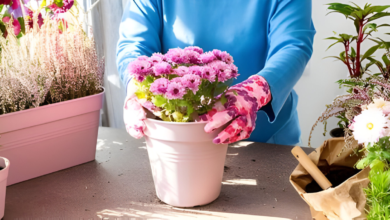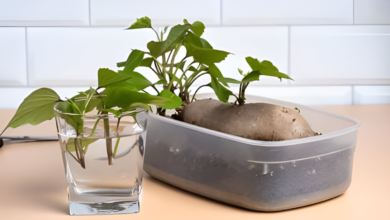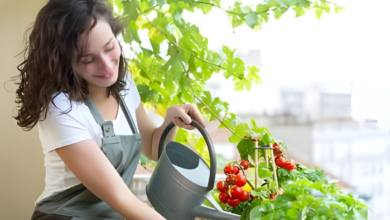How to Plant Succulents in Containers without Drainage Holes

Here’s an overview:
- Understanding the Importance of Drainage in Succulent Containers
- Choosing the Right Containers for Succulents without Drainage Holes
- Preparing the Container for Planting
- Selecting the Appropriate Soil Mix for Succulents
- Planting and Caring for Succulents in Containers without Drainage Holes
- Monitoring and Adjusting Watering Practices
- Recognizing Signs of Overwatering and Underwatering
- Managing Potential Pests and Diseases
- Creative Display and Maintenance Tips for Succulent Containers
- Final Thoughts and Additional Tips
Understanding the Importance of Drainage in Succulent Containers
When it comes to growing succulents in containers, proper drainage is absolutely crucial. Succulents thrive in well-draining soil and are highly susceptible to root rot if their roots are sitting in waterlogged conditions. Here’s why drainage is so essential for succulent container planting:
- Preventing Root Rot: Without proper drainage, excess water can collect at the bottom of the container, leading to waterlogged soil. This creates a damp environment that encourages root rot, a common issue that can quickly kill succulent plants.
- Balancing Moisture Levels: Succulents are adapted to survive in dry conditions by storing water in their leaves and stems. They prefer soil that dries out between waterings. Adequate drainage helps maintain the right moisture balance, preventing the roots from staying too wet.
- Avoiding Pest Infestations: Standing water in containers without drainage can attract pests like fungus gnats and root mealybugs, which thrive in damp environments. Proper drainage reduces the risk of infestations by keeping the soil from becoming excessively moist.
- Promoting Healthy Growth: Healthy roots are essential for the overall well-being of succulents. Good drainage allows the roots to receive oxygen and nutrients while preventing them from suffocating in waterlogged soil.
In conclusion, understanding the importance of drainage in succulent containers is crucial for successfully growing these plants. Proper drainage helps prevent root rot, maintains the right moisture levels, reduces the risk of pests, and promotes healthy growth.
Choosing the Right Containers for Succulents without Drainage Holes
When selecting containers for succulents without drainage holes, it’s essential to prioritize their well-being by ensuring proper moisture management. Here are some key considerations to keep in mind:
- Size Matters: Opt for containers that provide ample room for your succulents’ roots to grow. I recommend choosing pots that are slightly larger than the current root ball to prevent overcrowding.
- Material Selection: Porous materials like unglazed ceramics, terra cotta, or hypertufa are ideal choices as they allow for better airflow and moisture evaporation. These materials help prevent waterlogging, which can lead to root rot.
- Self-Monitoring: Since drainage holes are absent, it’s crucial to stay vigilant about watering. Monitoring the moisture levels in the soil regularly will help prevent overwatering, which is a common issue with containers lacking drainage.
- Layering for Drainage: Create a drainage layer at the bottom of the container using materials like pebbles or activated charcoal. This layer helps to avoid water pooling at the roots of your succulents.
- Use a Well-Draining Soil Mix: Prepare a well-draining soil mix by combining potting soil with coarse sand or perlite. This mix promotes adequate drainage and prevents water retention, safeguarding your succulents from excess moisture.
- Elevate the Pot: Resting your container on pot feet or a saucer with pebbles underneath can enhance airflow, reduce the risk of water accumulation, and protect your surfaces from potential water damage.
By carefully considering these factors when choosing containers for succulents without drainage holes, you can create a thriving environment for your plants while maintaining optimal moisture levels.
Preparing the Container for Planting
When planting succulents in containers without drainage holes, it’s crucial to take extra care in setting up the container properly to ensure the plants thrive in their new environment. Follow these steps to prepare the container for planting:
- Selecting the Right Container: Look for a container that is both aesthetically pleasing and functional. Choose a container that is shallow and wide to provide ample space for the succulents’ roots to spread out.
- Adding Drainage Material: To prevent water from pooling at the bottom of the container and causing root rot, add a layer of drainage material such as pebbles, rocks, or broken pottery. This layer will allow excess water to drain away from the roots.
- Using Well-Draining Soil: Use a well-draining potting mix specifically formulated for succulents and cacti. Avoid regular garden soil, as it tends to retain too much moisture, which can harm succulents that are prone to root rot.
- Creating a Drainage Layer with Activated Charcoal: Adding a thin layer of activated charcoal on top of the drainage material can help absorb excess moisture and prevent odors in the container.
- Positioning the Plants: Before planting the succulents, plan out their arrangement in the container. Leave enough space between each plant to allow for growth and airflow.
By following these steps, I can ensure that the container is well-prepared for planting succulents without drainage holes, creating a healthy environment for these resilient plants to thrive.
Selecting the Appropriate Soil Mix for Succulents
I always prioritize selecting the right soil mix when planting succulents in containers without drainage holes. Here are some key points to consider when choosing the appropriate soil mix:
- Well-draining soil: Succulents despise sitting in waterlogged soil as it can lead to root rot. I opt for a well-draining soil mix to prevent excess water retention.
- Sandy or rocky soil: Adding sand or small rocks to the soil mix improves drainage and aeration, which are crucial for succulents’ root health.
- Perlite or pumice: Incorporating perlite or pumice in the soil mix enhances drainage and prevents compaction, creating an ideal environment for succulents to thrive.
- Avoid heavy organic materials: While organic matter is beneficial, I steer clear of heavy materials like peat moss or coconut coir that can retain too much moisture.
When blending the soil mix for my succulents, I usually follow this ratio:
50% – Succulent/cactus potting mix 25% – Perlite or pumice 25% – Coarse sand or small rocks
This ensures that the soil provides ample drainage while still offering some nutrients for the plants. Remember, succulents have unique soil requirements, and providing the right mix is essential for their overall health and growth.
Planting and Caring for Succulents in Containers without Drainage Holes
When planting succulents in containers without drainage holes, extra care is essential to prevent waterlogged soil which can lead to root rot. Follow these steps to ensure your succulents thrive in such containers:
- Choose the Right Container: Opt for a container with adequate depth and width to accommodate your succulent’s roots. Ensure the container has good drainage at the bottom.
- Use the Correct Soil Mixture: Create a well-draining soil mixture by combining potting soil with perlite or coarse sand. This helps prevent water from pooling at the bottom of the container.
- Lay a Drainage Layer: Place a layer of rocks, pebbles, or charcoal at the bottom of the container before adding the soil. This helps improve drainage and prevents the roots from sitting in standing water.
- Monitor Watering Carefully: Succulents in containers without drainage holes are prone to overwatering. Water sparingly, allowing the soil to dry out between waterings. Insert a moisture meter into the soil to gauge moisture levels accurately.
- Provide Adequate Light: Succulents thrive in bright, indirect light. Ensure your container is placed in a location where your plants receive ample sunlight throughout the day.
- Avoid Cold Temperatures: Most succulents are sensitive to cold temperatures. Protect your container from frost by bringing it indoors during colder months or providing insulation.
By following these guidelines, you can successfully plant and care for succulents in containers without drainage holes. Remember, proper watering and lighting are key to ensuring your succulents remain healthy and vibrant.
Monitoring and Adjusting Watering Practices
When planting succulents in containers without drainage holes, monitoring and adjusting watering practices becomes crucial to prevent overwatering and root rot. Here are some tips for effectively managing the watering regimen:
- Observation is Key: Pay close attention to your succulents and observe them regularly. Look for signs of overwatering such as yellowing leaves, mushy stems, or a foul odor emanating from the soil.
- Touch Test: Before watering your succulents, perform a touch test. Press your finger into the soil to check for moisture. If the soil feels damp, wait a few more days before watering again.
- Adjust Watering Frequency: Succulents in containers without drainage holes may require less frequent watering compared to those in pots with proper drainage. It’s essential to adapt your watering schedule accordingly.
- Use a Spray Bottle: Instead of pouring water directly onto the soil, consider using a spray bottle to mist the soil lightly. This method helps control the amount of water you’re adding to the container.
- Watering from the Bottom: Another technique to prevent overwatering is bottom watering. Place the container in a shallow tray of water and allow the soil to soak up moisture from the bottom. Once the top layer feels damp, remove the container from the water.
- Dry Soil Between Watering: Allow the soil to dry out completely between watering sessions. This helps prevent waterlogged conditions that can lead to root rot.
By closely monitoring your succulents and adjusting your watering practices accordingly, you can successfully cultivate these plants in containers without drainage holes. Remember, it’s better to underwater than overwater when it comes to succulents.
Recognizing Signs of Overwatering and Underwatering
When caring for succulents planted in containers without drainage holes, it’s crucial to be attentive to signs of overwatering and underwatering. Here are some indicators to help you determine if your succulents are getting the right amount of water:
- Overwatering Signs:
- Yellowing or translucent leaves that feel mushy to the touch.
- Wilting or a “deflated” look to the succulent.
- Soft or mushy stems.
- Foul smell coming from the soil, indicating root rot.
When observing these signs, it’s essential to adjust your watering routine to prevent further damage to your succulents.
- Underwatering Signs:
- Shrinking or withering of the leaves.
- Dry, crispy, or brittle leaves.
- Slow or stunted growth of the plant.
- Leaf drop or loss of lower leaves first.
If you notice these symptoms, make sure to gradually increase watering frequency while still being cautious not to overwater.
As I tend to my succulents without drainage holes, I pay close attention to these signs. By monitoring the condition of the plants and their soil regularly, I can adjust my watering schedule accordingly to ensure they thrive in their container environment.
Managing Potential Pests and Diseases
When planting succulents in containers without drainage holes, it’s important to be mindful of potential pests and diseases that can affect the health of your plants. Here are some strategies I recommend to manage these issues:
- Overwatering: Since there are no drainage holes in the container, it’s easy to overwater your succulents. To prevent this, I make sure to water sparingly and allow the soil to dry out completely between waterings. This helps avoid root rot and other water-related diseases.
- Fungus Gnats: These pesky insects are attracted to moist soil, which can become a breeding ground in containers without drainage holes. To combat fungus gnats, I use a top dressing of sand or small pebbles to cover the soil surface, reducing moisture and deterring these pests.
- Mealybugs and Aphids: These common pests can also be a problem with succulents grown in containers. I regularly inspect my plants for any signs of mealybugs or aphids and if I spot any, I gently wipe them off with a cotton swab dipped in rubbing alcohol.
- Preventative Measures: To further prevent pests and diseases, I keep my succulents in a well-ventilated area with plenty of sunlight. I also avoid overcrowding my plants, as good air circulation can help prevent issues like powdery mildew.
- Diseases: While succulents are generally hardy plants, they can still be susceptible to diseases like root rot or powdery mildew. To prevent these issues, I make sure to remove any dead leaves or plant debris from the container and avoid splashing water onto the foliage when watering.
By following these practices and keeping a watchful eye on your succulents, you can effectively manage potential pests and diseases even in containers without drainage holes.
Creative Display and Maintenance Tips for Succulent Containers
- Vertical Gardens: I love creating vertical displays by attaching succulent-filled containers to a trellis or mounting them on the wall. This not only adds a decorative flair but also saves space, making it ideal for small areas or apartments.
- Mix and Match: Experiment with different shapes, sizes, and colors of containers to create an eye-catching display. Grouping varying heights and textures together can make a visually appealing arrangement.
- Rotate Containers: To ensure all sides of your succulents receive adequate sunlight, rotate the containers regularly. This helps prevent uneven growth and encourages even distribution of sunlight for healthier plants.
- Use Decorative Toppings: Add a layer of gravel, colorful stones, or sea glass on top of the soil for a decorative touch. Not only does this enhance the visual appeal of your succulent container but also helps with moisture retention and prevents soil erosion.
- Prune and Propagate: Keep your succulents looking neat and compact by trimming off any dead or overgrown leaves. Additionally, consider propagating healthy clippings to expand your succulent collection or create gift arrangements for friends and family.
- Monitor Watering Cycles: Without drainage holes, it’s crucial to water succulents sparingly to avoid root rot. Check the soil moisture by inserting a finger into the soil; only water when the top inch is dry. Overwatering is a common issue with succulents in containers without drainage, so it’s vital to practice restraint.
- Provide Adequate Light: Most succulents thrive in bright, indirect sunlight. Ensure your containers are placed near a sunny window or under grow lights if natural light is limited. Keep an eye on your plants and adjust their location as needed to prevent sunburn or etiolation.
These creative display and maintenance tips will help you enjoy your beautiful succulent containers while ensuring the health and longevity of your plants.
Final Thoughts and Additional Tips
When planting succulents in containers without drainage holes, it’s essential to pay attention to the watering habits and soil preparation to ensure the health and longevity of your plants. Here are some final thoughts and additional tips to keep in mind:
- Monitor Watering Carefully: Since there are no drainage holes, it’s easy to overwater the succulents. Check the moisture levels in the soil regularly before watering to prevent root rot.
- Use a Well-Draining Soil Mix: Opt for a specialized succulent or cactus mix that provides good aeration and drainage. You can also add perlite or sand to regular potting soil to improve drainage.
- Consider a Layer of Drainage Material: Placing a layer of pebbles, rocks, or activated charcoal at the bottom of the container can help in drainage by creating space for excess water to accumulate without saturating the roots.
- Watering Techniques: Instead of watering on a fixed schedule, water your succulents when the top inch of soil feels dry. Water thoroughly until it seeps through the soil, allowing the roots to soak up the moisture evenly.
- Monitor Plant Health: Keep an eye out for signs of overwatering, such as yellowing or mushy leaves. Adjust your watering frequency accordingly to maintain the health of your succulents.
- Rotate Your Container: To ensure even sun exposure and prevent etiolation, rotate your container every few weeks, especially if your succulents are indoors.
By following these tips and staying attentive to your plants’ needs, you can successfully plant and care for succulents in containers without drainage holes. Enjoy the beauty of these low-maintenance plants while creating a unique and eye-catching display in your living space.




